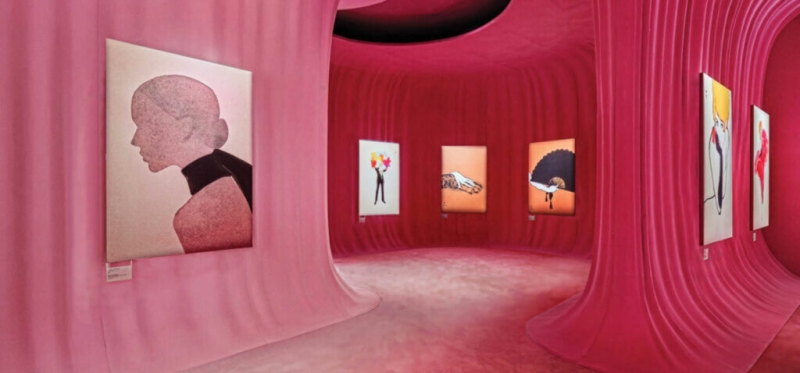For “Miss Dior: Story of a Miss,” a 9,150-square-foot, nine-room July exhibition at the Roppongi Museum in Tokyo by OMA that surveyed the 77-year history of the House of Dior scent, the dominant color derives from the pinks found in iterations of the perfume’s tinted formula and bottle designs.
Formulating a physical space for an ephemeral subject requires creative conceptual thinking. “We’re visualizing the invisible to some degree,” explains OMA partner Shohei Shigematsu, the architect who recently completed his first exhibition design for a scent, Miss Dior, the iconic perfume by Christian Dior that launched in 1947, nearly simultaneously with the French fashion house, making it integral to the brand’s identity. It’s a relationship that has been celebrated since 2013, with Miss Dior exhibitions over the past decade appearing in Paris, Shanghai, and Beijing, among other locations. Now, timed with a newly updated scent and campaign featuring actress Natalie Portman, Tokyo is part of the tour with “Miss Dior: Stories of a Miss” at the Roppongi Museum this summer, and for it, Shigematsu tapped into the rich history to create a nearly 10,000-square-foot experience that allowed visitors an in-depth look at the perfume’s influence, past and present.
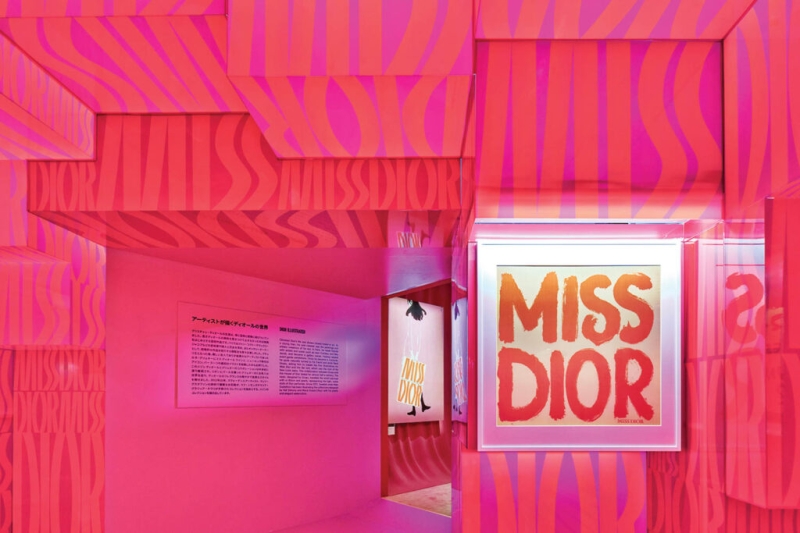
In the Miss Dior: The Birth of Ready-to-Wear gallery, the perfume’s logo from 1967, when Dior’s ready-to-wear line debuted, was abstracted into an all-over wall pattern.
Having previously collaborated with Dior on scenography for three retrospective exhibitions about the house—including “Christian Dior: Designer of Dreams,” which opened at the Museum of Contemporary Art Tokyo last year and focused on the connections between Dior and Japan—Shigematsu, who’s Japanese-born and New York-based, saw this commission as an opportunity to “zoom in” on a very specific, but less tangible, piece of the brand’s oeuvre. After researching the scent-making process, that intangibility became a benefit. “We found the technique of making a perfume, building up layered notes to choreograph people’s senses, similar to the narrative of architectural design,” the architect recalls. However, unlike a building—or couture, for that matter—a fragrance has no relatable human-scale. “That was the hint at a direction to play with,” he says, “the sense of scale, color, smell.”
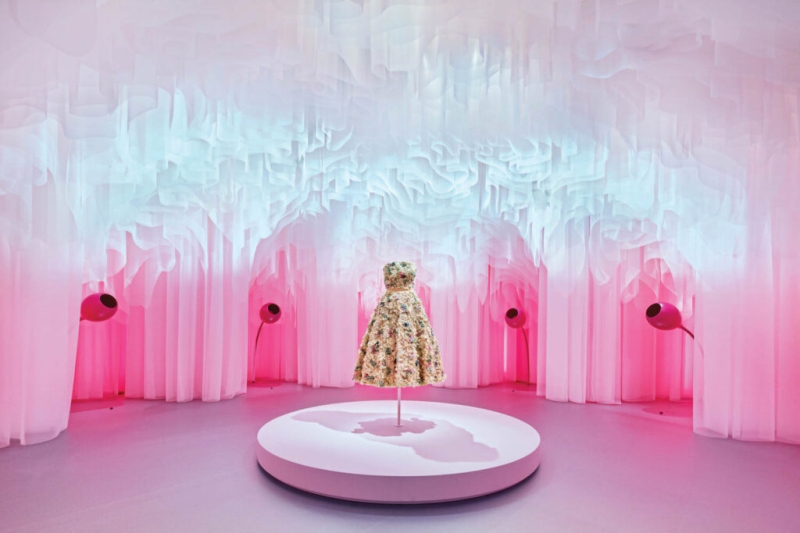
Evoking petals in the Fields of Flowers gallery, layers of georgette hung from the ceiling, unveiling five stamenlike scent atomizers.
Thus, “Tokyo’s Miss Dior: Stories of a Miss” encompassed nine galleries, each a unique environment highlighting a facet of Miss Dior, from its bouquet fragrance (called Fields of Flowers) to the commissioned artworks (Dior Illustrated) and fashions (Miss Dior Dream) that launched in tandem with its editions over the house’s 77-year history. Most of the zones were marked by shades of pink, drawn either from OMA’s research into the iterations of the blush-tinted Miss Dior perfume formula and bottle designs or such elements of its ephemera as the ready-to-wear collection’s graphic logo from the 1960’s. “By enveloping or flooding the rooms with pink hues, we sought to convey the vibrant and surreal aura of the Miss Dior identity,” Shigematsu continues.
The spaces varied in size: The first was vast and unforgivably magenta, hosting an oversize, 3D-printed Miss Dior bottle rotating inside a vitrine; the next was quiet and pristine, a domed space with walls upholstered in embroidered tapestries and printed fabrics by French artist Eva Jospin, a Dior collaborator whose limited-edition fragrance trunk was centered on a pedestal. Fields of Flowers brought the museumgoer within the petals of a blossom, a fantasy created by installing layers of gauzy white and pink fabric overhead and along the walls. These curtains parted to unveil five stamenlike atomizers that filled the room with the fragrance’s signature jasmine, rose, tuberose and orange blossom top notes. The fabric could also be projected upon, adding a digital element to the environment.
Leading the visitor in nonlinear movement through nonchronological rooms that expand and contract, and some—like Dior Illustrated’s sinuous, pink-carpeted gallery of fashion prints by historic and current Dior illustrators René Gruau and Mats Gustafson—that literally twist and turn, added to the fantastical feel. As did the gallery-by-gallery shifts in scale of Shigematsu’s visualizations. In the Stories of a Miss gallery, he and his team enlarged the perfume bottle’s signature ribbon into an LED-lit pathway, while elsewhere, life-size displays of limited-edition bottles, couture garments, and contemporary artworks by talents like Haruka Kojin, Sabine Marcelis, and Brigitte Niedermair grounded the show in time.
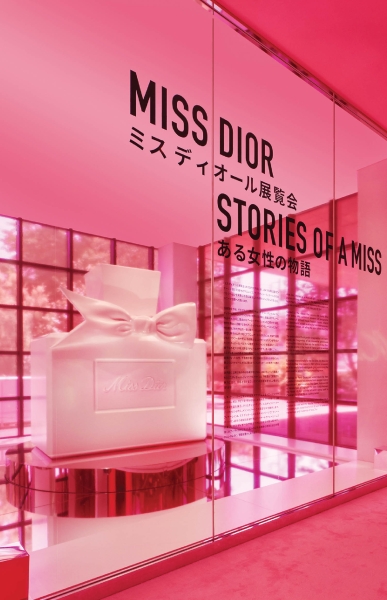
The entry’s 3D-printed fiberglass bottle stood nearly 8 feet tall and rotated.
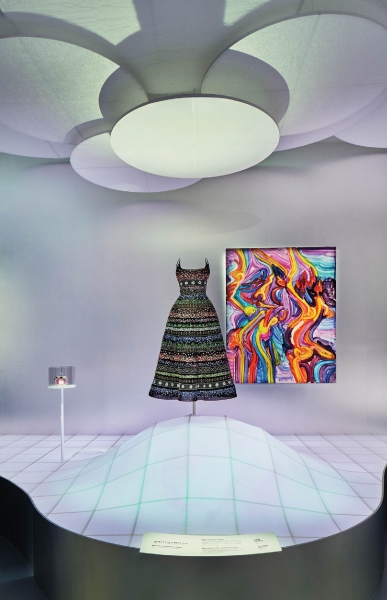
Curators paired a Dior dress from 2023 with Rainbow by emerging Japanese painter Etsu Egami.
But not necessarily in place. “The whole exhibition is like a lucid dream,” Shigematsu notes. “We created it to be a bit over the top in terms of color, configuration, and scale. It’s a kind of abstract landscape.”
In addition to capturing the “aura” of Dior and its fragrance, this tendency toward the surreal is purposeful storytelling. Both the experience-based visitor looking for photographable moments and the true aficionado who wants to dive deeply into the content could find a path through the show, its macro focus on a singular product allowing Dior to tell many tangential tales about its history. And with a penchant for craft, and a desire to highlight the quality of their own, fashion houses at large are keen for architects to design such highly detailed, immersive spaces that present new materials or methods, their patronage creating association with the cutting-edge.
It’s a far cry from the white box displays that have dominated exhibit design over the last 10 years, adds Shigematsu, who has also conceived recent exhibitions for Louis Vuitton, Prada, and the Metropolitan Museum of Art’s Costume Institute. “Fashion labels are using this kind of show to imprint their brand but also destabilize it,” the architect says, who goes on to explain the commission’s personal advantages. “For me, there’s something exciting about the sense of expression and liberation in creating a non-ordinary world. I’m training a different muscle in my brain—I’m sure it will have some effect on the future architecture I make.” Call it the smell of success.
Walk Through The Miss Dior Exhibition in Tokyo
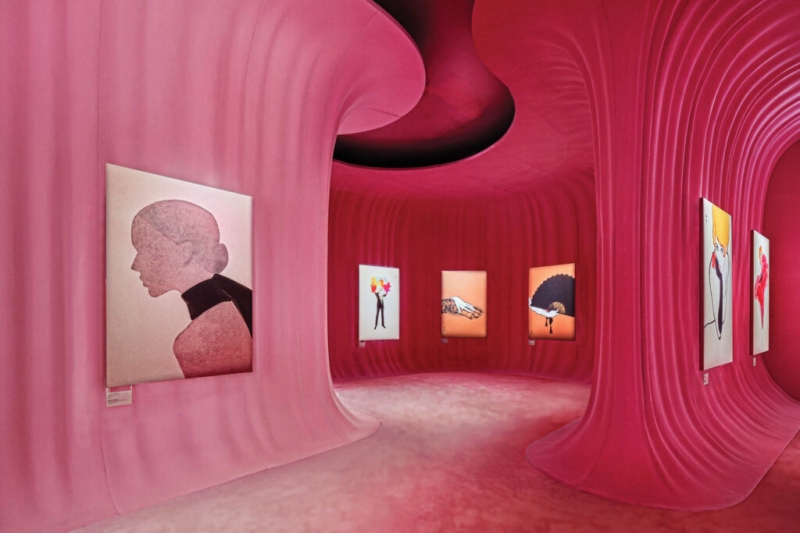
For “Miss Dior: Story of a Miss,” a 9,150-square-foot, nine-room July exhibition at the Roppongi Museum in Tokyo by OMA that surveyed the 77-year history of the House of Dior scent, the dominant color derives from the pinks found in iterations of the perfume’s tinted formula and bottle designs.
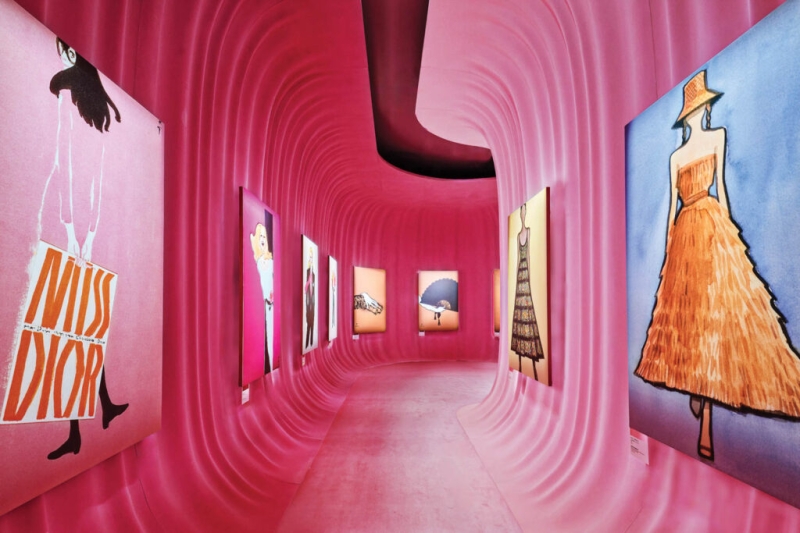
Carpeting and partitions of cotton-flocked fiberglass molded to look draperylike define Dior Illustrated, most like a traditional gallery, displaying 20 prints of original Dior illustrations by René Gruau and Mats Gustafson.
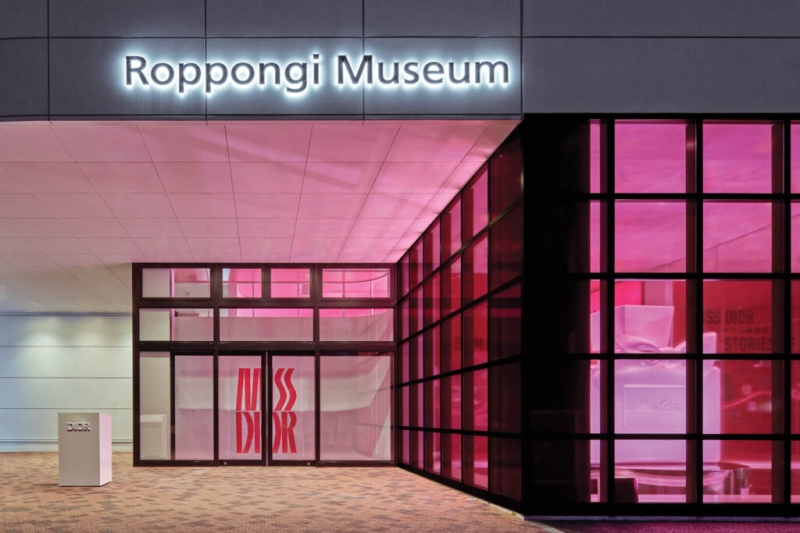
The museum entry featured windows tinted with vinyl film.
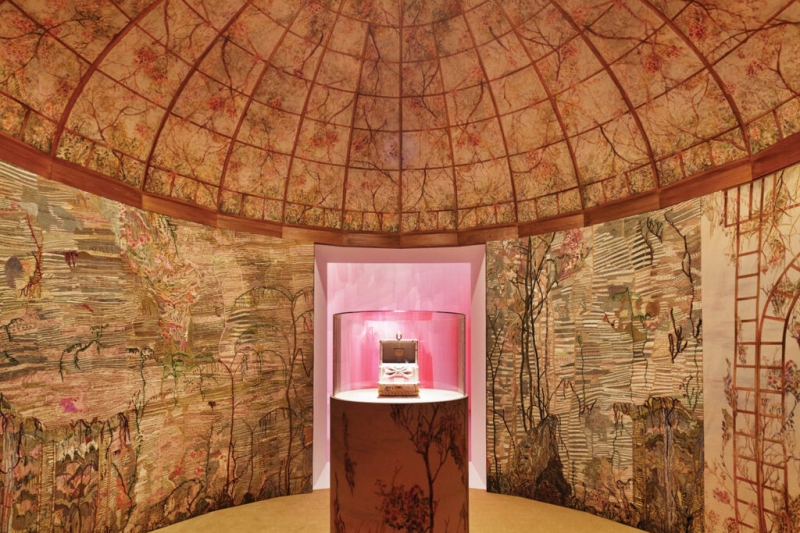
In the domed Miss Dior by Eva Jospin gallery, tapestries by the French artist surrounded the recently launched Miss Dior Parfum, which comes in Jospin’s embroidered limited-edition mini trunk.
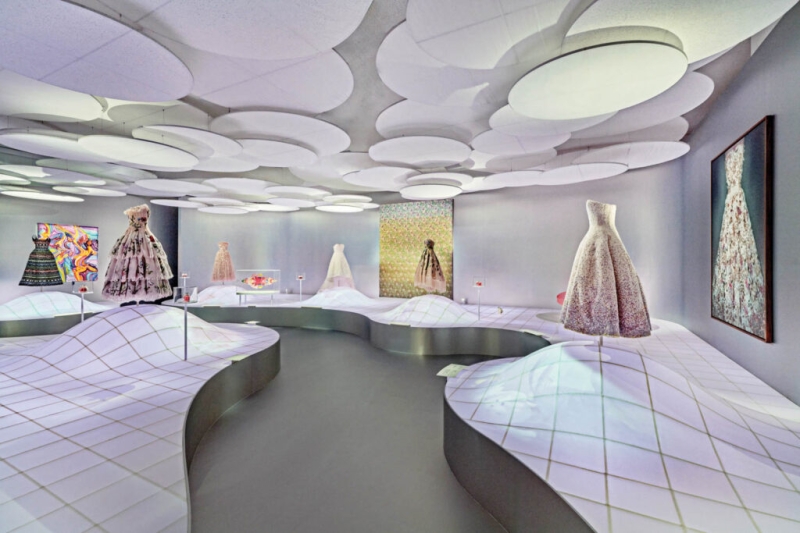
Amid aluminum Dibond flooring and paneling, washi paper stretched over metal structures created the disk-covered ceiling and knolly plinths in the Miss Dior Dream gallery showcasing Christian Dior couture, unique Miss Dior bottles, and commissioned artworks.
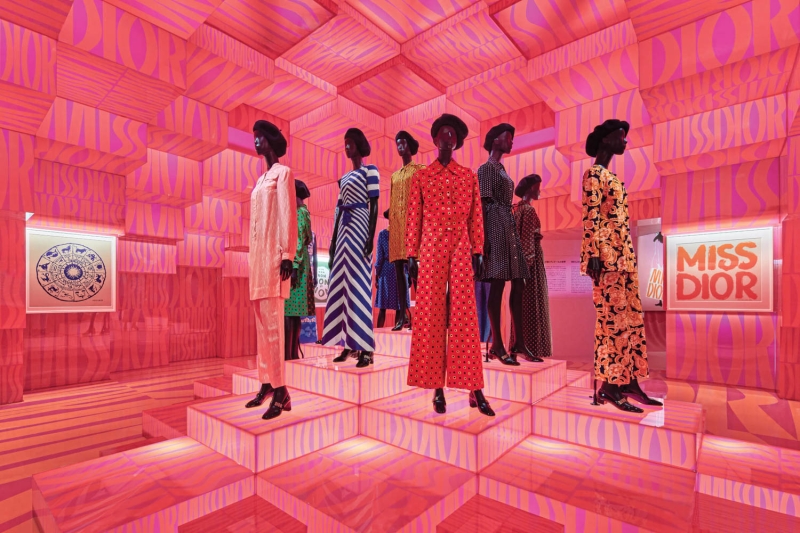
Mannequins donning ready-to-wear from the ’60’s stood atop acrylic boxes also printed with abstracted versions of the original logo.
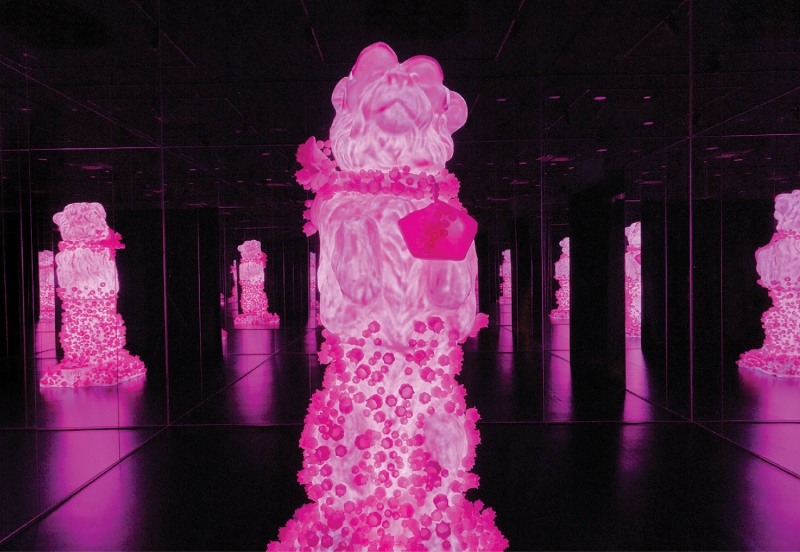
A 7-foot-tall, plastic version of the Bobby bottle, first designed in 1952 and named for Christian Dior’s dog, then relaunched as a special edition in 2022, was backlit by custom pink LEDs in the mirrored final gallery.
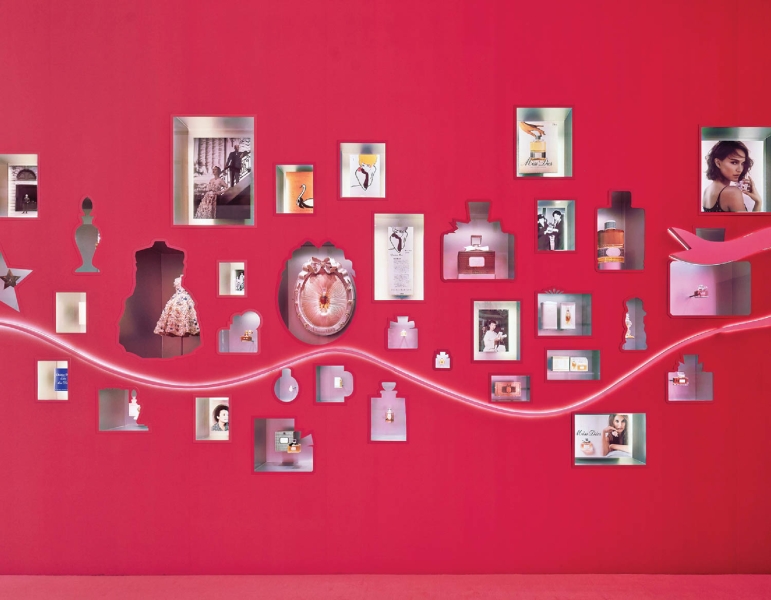
The Stories of a Miss gallery introduces the signature bow on every Miss Dior bottle neck as a design concept.
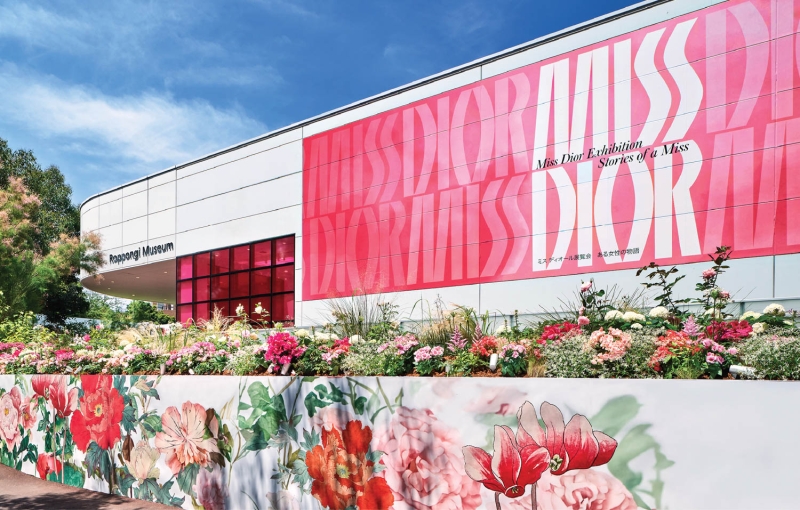
A vinyl print of a Japanese woodblock-style floral emblazoned the large planter box at the entrance to the Roppongi Museum.
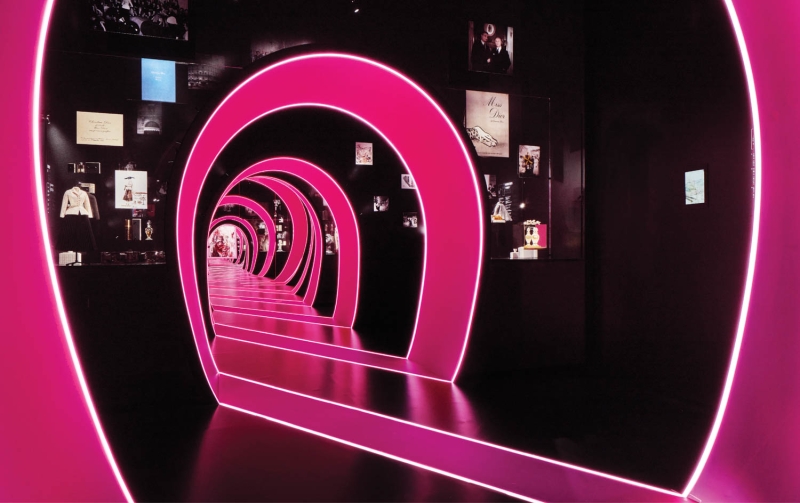
An LED-lit aluminum “ribbon” wrapped the pathway through the Stories of a Miss gallery, with eight double-sided vitrines displaying artifacts related to the history of the perfume.
PROJECT TEAM
CHRISTY CHENG; JAN CASIMIR; BAIYANG KONG; TIMOTHY HO; FRANCESCA PARMIGGIANI; CHRISTINE DOPPLE: OMA. NPU CORPORATION: PRODUCTION. ANAMORPHÉE: GRAPHIC DESIGN. BRANCO INC.; JIN CRAFT CORPORATION; STUDIO 97: EXHIBIT FABRICATION. TAKENAKA CORPORATION: AUDIOVISUAL. RENO ISAAC: SOUND.
PRODUCT SOURCES
FROM FRONT STUDIO JOSPIN: TAPESTRIES, FABRIC (MISS DIOR BY EVA JOSPIN GALLERY). SANKYO KAMITEN: WASHI PAPER (MISS DIOR DREAM GALLERY).
